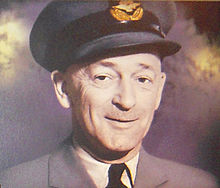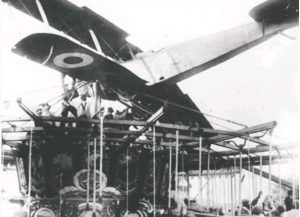MCCALL, Fred (1896-1949)
Frederick Robert Gordon McCall
Canadian air ace in World War 1
 Born: 4 Dec 1896 at Vernon, British Columbia
Born: 4 Dec 1896 at Vernon, British Columbia
Married: Genevieve Mullins Strong
Died: 22 Jan 1949 (age 52) at Calgary, Alberta
Buried: Burnsland Cemetery, Calgary, Alberta, plot T:03:085
Contributor: Jim Benedict
His Early Years
Born in Vernon, British Columbia, McCall came to Calgary with his family in 1906. In February 1916 when his father, James F. McCall, became superintendent of the city’s electric power plant. At age 19, McCall enlisted with the 175th Battalion of the Canadian Expeditionary Force (CEF) as a private. Eight months later, he was in France with this battalion as a sergeant.1
McCall expressed interest in transferring from the army to the RFC and received a commission as a lieutenant pilot trainee in March 1917. In December he was assigned to No. X111 Squadron on the Western Front, flying the two seater Royal Aircraft Factory R.E.8 reconnaissance aircraft with F.C. Farrington.2
World War One
 McCall’s first aerial victory occurred while flying the R.E.8, shooting down a German aircraft. McCall was awarded the Military Cross “for conspicuous gallantry and devotion to duty”, and two weeks later the accompanying Bar for downing an enemy scout aircraft while on a mission to take photographs.
McCall’s first aerial victory occurred while flying the R.E.8, shooting down a German aircraft. McCall was awarded the Military Cross “for conspicuous gallantry and devotion to duty”, and two weeks later the accompanying Bar for downing an enemy scout aircraft while on a mission to take photographs.
After his third victory while flying the R.E.8, McCall was next transferred to No. 41 Squadron RAF and began flying the Royal Aircraft Factory S.E.5. He was awarded the Distinguished Flying Cross after scoring four “kills” in May 1918. On 28 June 1918 McCall downed four enemy aircraft, including one shared with Eric John Stephens. On 30 June 1918 now Captain McCall downed five more Germans, four in the morning and the fifth that evening. For this McCall was awarded the Distinguished Service Order.
On 17 August, he was accompanying William Gordon Claxton when the pair of them ran into Jagstaffel 20, which consisted of at least 40 planes. In the ensuing fight, which saw Claxton shot down, McCall scored a victory.
McCall was ordered to England, and eventually to Canada, on convalescent leave. The armistice ending World War I was signed while McCall was in Canada recuperating from illness.
Crash at Stampede Exhibition
Following the armistice McCall embarked upon a variety of civil aviation ventures, beginning with stunt flying, or “barnstorming”. During the early years, he was in the forefront of every advance in aviation.

McCall crash at Calgary Stampede 1919
One of Fred’s most famous flights took place at the 1919 Calgary Stampede. He had just taken off with two young passengers, the sons of Calgary Exhibition manager E.L. Richardson, when his Curtiss JN-4D lost power. Unable to land on the infield because of an auto race, and seeking to avoid the Stampede crowds, he pancaked the plane on top of a the merry-go-round at the Calgary Exhibition and Stampede..
It was a masterful landing — no one was hurt. The plane was taken down, put in a tent, and pieces of it sold as souvenirs.
“I think he almost made enough to buy a new plane,” said his son, Fred Jr.
He founded his own company, McCall Aero Corporation Limited, in 1920. With this company McCall flew commercial freight and passengers across Canada, pioneering air travel to Banff.
In 1927, he founded and became the first president of the Calgary Aero Club. In 1928 he founded, with Emil Sick, another aviation company Great Western Airways. One of his more spectacular achievements was the flying of 200 quarts of nitroglycerin from Shelby, Montana to Calgary in 1for use in the new Turner Valley oilfields.
The following year, he ignored bad weather to fly a doctor to the Skiff oil fields to treat two seriously injured workers.
McCall also worked to encourage the formation of Canadian flying clubs in the inter-war years.
With the arrival of the Second World War McCall was recalled to service with the Royal Canadian Air Force as a Squadron Leader, based at numerous western Canadian bases.
Legacy
In the city of Calgary, Alberta, the McCall industrial park and the road “McCall Way” are named after him, as well as McCall Lake Golf Course. Freddie McCall appears in exhibits in several museums in and around Calgary such as the Glenbow Museum and the Calgary Aerospace Museum. In 1939 the Calgary Airport was named after him but has since been renamed Calgary International Airport. There is also a provincial electoral district bearing his name, Calgary-McCall, which was established in 1971.
Fred Robert Gordon McCall was inducted as a Member of Canada’s Aviation Hall of Fame in 1978 at a ceremony held in Edmonton, Alberta. A book entitled Mavericks History of Alberta contains some information on McCall as well.
McCall died in Calgary Alberta on 22 January 1949 of a heart attack at the age of 52. He is buried in the military section in Burnsland Cemetery. His spouse, Genevieve Mullins [Strong] McCall and their two children, Gerrie and Fred Jr., are buried separately in Burnsland Cemetery at plot location F:19:081.3
- Alberta in the 20th Century Vol. 4 pp. 143-144 [↩]
- Wikipedia Fred McCall: https://en.wikipedia.org/wiki/Frederick_McCall [↩]
- Plot for Genevieve McCall [↩]
